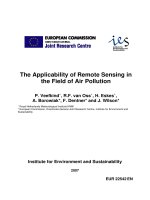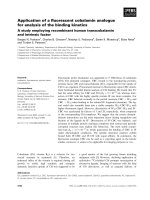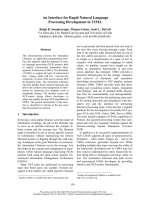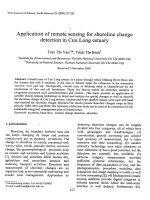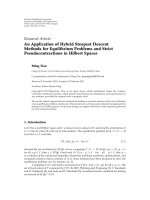Application of remote sensing an GIS for mangroves forest cover change detection in ngoc hien district ca mau province 1990 1995 2016
Bạn đang xem bản rút gọn của tài liệu. Xem và tải ngay bản đầy đủ của tài liệu tại đây (1.58 MB, 54 trang )
ACKNOWLEDGEMENT
The success and result of this project required a lot of guidance and assistance from
many people and I am extremely fortunate to have this all along the completion of my project
work. Whatever I have done is only due to such guidance and assistance and I would not
forget to thank them.
A special thanks to Assoc. Prof. PhD. Phung Van Khoa, who advised us throughout
this study. Without his enthusiasm and advice, it is unlikely this work would have been
completed and for that we are truly grateful.
I am thankful to and fortunate enough to get constant encouragement, support and
guidance from teachers in Vietnam National University of Forestry.
I would like to thank the staffs and foresters in the Dat Mui and Nhung Mien
Mangrove Forest Management Board for their support and assistance.
Students:
Trinh Nam Phong
1
ABSTRACT
Ngoc Hien is known as the southernmost rural district of Ca Mau, Vietnam with the
extensive mangrove forest areas and availability. Therefore, the detection of forest cover
change annually is very necessary in order to have sensible management methods. Through
researching, we recognized that the flora in Ngoc Hien is quite abundant and mostly is
mangrove species. The mangrove forest area increases continuously through periods 1990 –
1995 – 2016. The forest lost area decreased significantly from 1995 to 2016. It proves that
local people in Ngoc Hien have had more awareness about protecting forest. The application
of RS and GIS to detect mangrove forest cover changing is very useful. It helps us to shorten
the time to research and give us the high accurate results.
Keywords: Remote sensing; Forest Cover Change; application of GIS; construct
map…
2
ACRONYMS
RS:
Remote Sensing
GIS:
Geographical Information System
TM:
Thematic Mapper
MSS:
Multi-spectral Scanner
SPOT:
Satellite Probatoire d'Observation de la Terre
NDVI :
Normalized Difference Vegetation Index
ENVI :
Environment for Visualizing Images
3
CONTENTS
CHAPTER I. INTRODUCTION ............................................................................................... 1
CHAPTER II. LITERATURE REVIEW ................................................................................... 3
2.1. General definition about Remote Sensing and GIS ............................................................. 3
2.2. Application of Remote Sensing and GIS ............................................................................. 3
CHAPTER III. OBJECTIVES, CONTENTS AND METHODOLOGY ................................... 6
3.1. Goal and objectives: ............................................................................................................ 6
3.1.1. Goal: ................................................................................................................................. 6
3.1.2. Objectives: ........................................................................................................................ 6
3.2.Contents: ............................................................................................................................... 6
3.2.1. Collecting materials related to the status of forest cover in Ngoc Hien (Ca Mau) in the
period (1990 - 1995- 2016) ......................................................................................................... 6
3.2.2. Construct map and detect forest cover change in Ngoc Hien in the period (1990 - 19952016) ........................................................................................................................................... 6
3.2.3. Propose some solutions for effective and sustainable forest managing and using in Ngoc
Hien (Ca Mau) ............................................................................................................................ 7
3.3.Methodology: ....................................................................................................................... 7
3.3.1.Collecting materials related to the study ........................................................................... 7
3.3.2.Image Acquisition and Pre-processing .............................................................................. 7
3.3.3.Software ............................................................................................................................. 8
3.3.4.Image Interpretation .......................................................................................................... 8
3.3.5.Fieldwork ......................................................................................................................... 21
CHAPTER IV. NATURAL AND SOCIOECONOMIC CHARACTERISTICS OF THE
STUDY SITE ........................................................................................................................... 24
4.1. Natural characteristics ....................................................................................................... 24
4
4.1.1. Geography ...................................................................................................................... 24
4.1.2. Terrain ............................................................................................................................ 25
4.1.3. Climate ........................................................................................................................... 25
4.1.4. Hydrology ....................................................................................................................... 25
4.1.5. Natural Resources ........................................................................................................... 25
4.2. Socioeconomic characteristics ........................................................................................... 26
4.2.1. Social characteristics ...................................................................................................... 26
4.2.2. Economic characteristics ................................................................................................ 26
4.3. Mangroves and roles of mangroves in Ngoc Hien- Ca Mau ............................................. 26
Chapter V. RESULTS .............................................................................................................. 28
5.1. Results of fieldwork combine with interpret Landsat image ............................................. 28
5.2. Forest cover change map in periods 1990 – 1995 – 2016 ................................................. 37
5.2.1. Forest cover change map in 1990 ................................................................................... 37
5.2.2.Forest cover change map in 1995 .................................................................................... 38
5.2.3. Forest cover change map in 2016 ................................................................................... 40
5.3.Reason causing forest cover change in Ngoc Hien district and solutions .......................... 41
5.3.1. Reason causing forest cover change in Ngoc Hien district ............................................ 41
5.3.2.Propose solutions ............................................................................................................. 42
Chapter VI. CONCLUSION, LIMITATION AND FUTHER STUDY .................................. 44
6.1. Conclusion ......................................................................................................................... 44
6.2. Limitation and further study .............................................................................................. 44
REFERENCES
5
LIST OF TABLES
Table 3.1. Landsat Satellite Images used in the study ................................................................ 7
Table 3.2. Image Classification ................................................................................................ 17
Table 3.3. Matrix to assess the accuracy .................................................................................. 22
Table 5.1. Area of lost and exploited forest Statistic in 1990 .................................................. 37
Table 5.2. Area of lost and exploited forest Statistic in 1995 .................................................. 38
Table 5.3. Area of lost and exploited forest Statistic in 2016 .................................................. 40
6
LIST OF CHARTS
Chart 5.1. Forest cover change in 1990 .................................................................................... 37
Chart 5.2. Forest cover change in 1995 .................................................................................... 39
Chart 5.3. Forest cover change in 2016 .................................................................................... 40
7
LIST OF FIGURES
Figure 3.1. Defaults setup ........................................................................................................... 9
Figure 3.2. Import data ............................................................................................................... 9
Figure 3.3: Change the default and add bands created. ............................................................ 10
Figure 3.4. Modify images ....................................................................................................... 11
Figure 3.5. Layer stacking ........................................................................................................ 12
Figure 3.6. Process of Creating Subset Image .......................................................................... 13
Figure 3.7. Image of the study area after cutting ...................................................................... 14
Figure 3.8. Edit signature ......................................................................................................... 15
Figure 3.9. Assessing the quality of image choosing ............................................................... 16
Figure 3.10. Image before purifying ......................................................................................... 18
Figure 3.11. Image after purifying............................................................................................ 19
Figure 3.12. Exclude subjects out of the study area ................................................................. 20
Figure 3.13. Processing of changing from Raster into Vector ................................................. 21
Figure 3.14. Overall steps to collect information ..................................................................... 22
Figure 3.15. Overall steps to process information .................................................................... 23
Figure 4.1. The Study Area ...................................................................................................... 24
Figure 5.1. Forest Cover Change detection in 1990 ................................................................. 38
Figure 5.2. Forest Cover Change detection in 1995 ................................................................. 39
Figure 5.3. Forest Cover Change detection in 2016 ................................................................. 41
8
LIST OF PHOTOS
Photo 5.1. Photo in the field 1 .................................................................................................. 28
Photo 5.2. Photo in the field 2 .................................................................................................. 29
Photo 5.3. Photo in the field 3 .................................................................................................. 30
Photo 5.4. Photo in the field 4 .................................................................................................. 31
Photo 5.5. Photo in the field 5 .................................................................................................. 32
Photo 5.6. Photo in the field 6 .................................................................................................. 33
Photo 5.7. Photo in the field 7 .................................................................................................. 34
Photo 5.8. Photo in the field 8 .................................................................................................. 35
Photo 5.9. Photo in the field 9 .................................................................................................. 36
9
CHAPTER I
INTRODUCTION
Besides getting benefits from forest exploitation and using, human activities such as
agriculture, mining, deforestation and construction... have caused many impacts on natural
resource and environment. Urban growth and its associated population increase is a major
factor, which has altered natural vegetation cover. This has resulted in a significant effect on
local weather and climate. Nowadays, we are facing with regression of natural resources and
environment. Economic development combining with protecting environment and natural
resources to develop sustainably is an urgent problem. To do this mission well, investigation monitoring - and assessment task is one of the most important task. Although each year there
are some reports about status of forest cover change, almost these reports based on
constructing map by rudimentary methods. It is very complex and time consuming and we
cannot find out most recent information from them because time for summarizing and
constructing is long, then the information in map is backward and not exact. While a good
map is required exact form, quick time and updating information. Therefore, we need new
methods to make good maps.
Nowadays, the development of science and technology, especially the births of
Geographical Information System (GIS), Remote Sensing (RS) and satellite images, helps us
so much to research forest cover change, study and propose some methods to manage the
natural resources and environment without direct contacts. Remote Sensing (RS) information
with many advantages like synchronous and updating information, broad covering ability and
covered everywhere in the Earth… and with rapid development of technology such as supply
information rapidly, exactly… brings to us authentic values of mapping methods in
researching relationships and reciprocal impacts of some phenomenon, subjects such as forest
cover change, forest resources change… Geographical Information Systems (GIS) can collect,
1
update, manage and analyze, represent geographical data in order to service applied
mathematics relating to geographical points of some subjects on the Earth. It is a bettersupported tool for natural resources and environment management, and planning.
In addition, Ca Mau is the coastal province in the south of Vietnam, where has a huge
ecological tourism potential. Along with abundant natural resources, Cau Mau is facing with
many disadvantages such as salt water intrusion, pollution, erosion… occurring in the whole
province. Especially, in recent years, forest cover change is the urgent problem in Ca Mau in
general and in Ngoc Hien in particular.
From these above reasons, we chose the topic: “Application of Remote Sensing and
GIS for Forest Cover Change Detection in Ngoc Hien district, Ca Mau province (1990 2016)”
2
CHAPTER II
LITERATURE REVIEW
2.1. General definition about Remote Sensing and GIS
Remote Sensing is the science of obtaining information about objects or areas from a
distance, typically from aircraft or satellites without any direct contact.
Geographical Information System (GIS) is a system designed to capture, store,
manipulate, analyze, manage & present all types of geographic data. GIS can show many
different kinds of data on one map. This enables people to more easily see, analyze, and
understand patterns and relationships.
Change detection is the process of identifying differences in the state of an object or
phenomenon by observing it at different times. Essentially, it involves the ability to quantify
temporal effects using multi-temporal data (Singh 1989). Remote sensing provides a viable
source of data from which updated land-cover information can be extracted efficiently and
cheaply in order to inventory and monitor changes effectively. Thus, change detection has
become a major application of remotely sensed data because of repetitive coverage at short
intervals and consistent image quality (Mas, 1999).
2.2. Application of Remote Sensing and GIS
The use of GIS and remotely sensed data in mapping different natural resources
management and environmental modeling are gaining mass momentum in recent years.
Majority of work in remote sensing was mainly focused on environmental studies in the last
few decades. The implication of Remote Sensing and Geographic Information System to
forest cover change and urban planning is now getting attention and interest among GIS and
remote sensing professionals. The techniques are becoming an important part of watershed
management, urban planning, hydrological modeling, drought prediction, and forest cover
mapping. Remote sensed data provide advantages like synoptic coverage, consistency in data,
3
global reach and readability, precision and maximum accuracy in data provision (Lambing,
E.F., 1997). Geographical Information System and Remote sensing has been efficiently and
widely used much in single thematic analysis such as land use and land cover change
mapping, forest monitoring , watershed management and forest fire management (Kachmar
and Sánchez-Azofeifa, 2003), and forest strategy appraisal…
There are many research projects applying RS and GIS in the world. Such as:
“Deforestation: Change Detection in Forest Cover using Remote Sensing” of Soraya
Violini (Argentina, 2013)
“Forest Cover Change Detection Using Remote Sensing and GIS – A Study of Jorhat
and Golaghat District, Assam” of Shukla Acharjee, Mayuri Changmai, Smita Bhattacharjee
and Junmoni Mahanta (India)
“Application of Remote Sensing and GIS for Forest Cover Change Detection (A case
study of Owabi Catchment in Kumasi, Ghana)” of Adubofour Frimpong (Ghana)
“Application of Remote Sensing and GIS in Forest Cover Change in Tehsil Barawal,
District Dir, Pakistan” of A. Sajjad et al. (Pakistan)
And many other projects. These projects use main tools that are RS and GIS combine
with other software like ERDAS, ENVI…
In Vietnam, Remote Sensing has been known since 1980, when Vietnam joined in the
International Space Station Interkosmos (Nguyen Xuan Lam, 1999). However, before 1990
the application of satellite images was limited because the condition of technique and
economy is poor. Since 1990 up to now, we have recognized the important roles of satellite
images so many ministries and branches like Ministry of Agriculture and Rural Development,
Ministry of Natural Resources and Environment, Department of Hydrology and
Meteorology… invested satellite images, equipment, trained people, and usually applied this
technology to service for many purposes in researching as well as daily life.
4
Up to now, there have been many scientific research projects applying RS and GIS of
ministries, branches, doctors, professors… even college students in Vietnam.
“Applying Remote Sensing and GIS to construct map of forest cover status in Cao Ky,
Cho Moi, Bac Kan” of Hua Phuc Hoang (2012). The author used SPOT 5 image in 2010
combined with ERDAS 9.1 software to interpret.
“Applying Remote Sensing and GIS to detect mangrove forest change” of Pham Viet
Hoa (2012). The author used SPOT 5 image in periods and NDVI to assess forest change.
“Applying Remote Sensing and GIS to detect land use change in Vinh Trai, Lang Son
(2003-2008)” of Le Thi Thuy Van (2010). The author used SPOT 5 image with a resolution of
2.5×2.5m and combined with ENVI software.
“Applying Remote Sensing and GIS to detect forest area change in Dao Tru, Lap
Thach, Vinh Phuc” of Nguyen Thi Tho (2009).
In general, we can recognize that Remote Sensing and GIS are used widely in many
different fields, especially in Natural resources and environment management. However,
because the system of forest maps in Vietnam were constructed in different time and referred
to many different information and image sources such as Landsat MSS, TM, SPOT, Aster,
and Radar…, there are inconsistent data. It is very difficult for users, especially in detecting
forest area change in periods.
5
CHAPTER III
OBJECTIVES, CONTENTS AND METHODOLOGY
3.1. Goal and objectives:
3.1.1. Goal:
Apply remote sensing and GIS to construct map and detect forest cover change in
Ngoc Hien district, Ca Mau province. From there, propose some solutions for effective and
sustainable forest managing and using in Ngoc Hien- Cau Mau. (1990 - 1995- 2016)
3.1.2. Objectives:
Objective 1: To collect materials related to the status of forest cover in Ngoc Hien (Ca Mau)
in the period (1990 - 1995- 2016)
Objective 2: To construct map and detect forest cover change in Ngoc Hien in the period
(1990 - 1995- 2016)
Objective 3: To propose some solutions for effective and sustainable forest managing and
using in Ngoc Hien (Ca Mau)
3.2.
Contents:
3.2.1. Collecting materials related to the status of forest cover in Ngoc Hien (Ca Mau) in
the period (1990 - 1995- 2016)
-
Collect information, data, materials, reports related to our research in Ca Mau in
periods (1990 - 1995- 2016) (Fieldwork)
-
Collect forest status maps in Ngoc Hien of periods (1990 - 1995- 2016)
-
Collect Landsat Satellite images in periods (1990 - 1995- 2016)
3.2.2. Construct map and detect forest cover change in Ngoc Hien in the period (1990 1995- 2016)
-
Classify, interpret visually Landsat Satellite images
-
Analysis data
6
-
Construct map of forest cover change in Ngoc Hien- Cau Mau (1990 - 1995- 2016)
3.2.3. Propose some solutions for effective and sustainable forest managing and using in
Ngoc Hien (Ca Mau)
-
Refer to materials and current situation in Ngoc Hien to find out reasons and propose
some solutions after surveying and constructing forest cover changing map.
3.3.
Methodology:
3.3.1. Collecting materials related to the study
-
Collect maps: forest status maps, forest exploitation maps… of the Nhung Mien and
Dat Mui Mangrove forest Management Board in 2016
-
Inherit materials, reports about natural, socioeconomic condition in Ngoc Hien, Ca
Mau
3.3.2. Image Acquisition and Pre-processing
For change detection over a period of time we required temporal satellite imagery of
same time period. Landsat Satellite images of periods (1990-1995-2016) were downloaded
from the website . Landsat L8 OLI/TIRS, Landsat L8 OLI/TIRS
Pre-WRS-2 and L4-5 TM satellite images were used in this study.
Date
Year
ID
Resolution
Path/row
required
1990
LT51250541990307BKT00
11/03/1990
30
125/54
1995
LT51250541995033BKT01
02/02/1995
30
125/54
LC81250542016123LGN00
02/05/2016
30
125/54
LC81250542016235LGN00
22/08/2016
30
125/54
2016
ơ
Table 3.1. Landsat Satellite Images used in the study
The Landsat Satellite Images must satisfy some standards as follow:
7
-
Images must have high homogeneousness of color or position…
-
When collecting data, we have to make sample plots in where we sample, measure,
describe forest status and land use characteristics…
3.3.3. Software
The processing of the satellite imagery during this research was carried out by using
the ERDAS Imagine 2014 software. Some specific image processing operations were done
using the ArcGIS software version 10.1.
3.3.4. Image Interpretation
Image interpretation comprises some steps below:
Step 1: Setup some map defaults (input and output links after processing…):
-
Start software ERDAS 2014
-
In Main menu we choose Preferences/ Preference Editor
-
Default Data Directory: Input file/ Default Data Directory: Output file
-
Viewing/ Viewer/ Fit to Frame and Background Transparent/ Save to save default
setup process
Simulation in Figure 3.1
8
Figure 3.1. Defaults setup
Step 2: Import data from storage equipment (USB, CD-ROM) into software:
-
On main menu choose Manage Data/ Import Data/ In Format we must choose the
exactly form of input Landsat image which is TIFF/ Input file/ ; choose Output file
which have default is .img
-
Add band 1 to band 6 in turn
Simulation in Figure 3.2
Figure 3.2. Import data
9
Right Click in 2D View #1→ Open Raster → change the default to file .img → add
bands created.
Simulation in Figure 3.3.
Figure 3.3: Change the default and add bands created.
Step 3: Modify images:
a. Intensify image quality:
-
Intensify image quality: is modify action to increase the readability and
understandability of images for interpreters.
-
Stack up layer: in order to visual interpret more clearly and exactly, we need to stack
up colors according to steps:
+ Raster/ Spectral/ Layer Stack
Input file: open all of color Bands (.img) from Band 1 to Band 6
Output file: Name as and navigate folder destination after stacking up bands/ OK.
Simulation in Figure 3.4.
10
Figure 3.4. Modify images
+ Choose color bands: Color Infrared (vegetation) red, green, blue (RGB)
+ Raster/ Multispectral: Red: band 5/ Blue: band 4/ Green: band 3.
Simulation in Figure 3.5
11
Figure 3.5. Layer stacking
Step 4: Create Subset Image in the study area:
A Landsat image often has large size causing high capacity. So it is so difficult to
process and interpret images. Layer stacking helps to create a concrete image in the study area
and easy to process and interpret images. Concrete steps as follow:
-
On main menu, choose Raster/ Subset & Chip/ Create Subset Image/
Input: Name of origin file
Output File: Destination of the image after cutting
12
→ Click in Ignore Zero in Output Stats.
-
Raster/ Drawing/ click on Polygon symbol and draw
-
On Box Subset, click on AOI tab/ Viewer/ OK.
Simulation in Figure 3.6.
Figure 3.6. Process of Creating Subset Image
13
Figure 3.7. Image of the study area after cutting
Step 5: Classify
Classify to separate information that is used to service monitoring objects or mapping.
This is the key step of Landsat images.
Identify number of types separated in the study area: exploited forest, mangrove forest
or water…
The order of steps as follow:
-
Edit signature:
+ On main menu, choose Raster/ Supervised/ Signature Editor
+ Click on the zigzag symbol (black circle on the Figure 3.8) to add in
+ Name as: Name/save file *.sig.
Simulation in Figure 3.8.
14
Figure 3.8. Edit signature
-
Assess the quality of image choosing:
+ In the dialog box Signature Editor, choose Evaluate/ Reparability
+ Distance measure/ Transformed Divergence
+ Output form/ Cell Array
+ Which Listing/ Best Average/ OK
If the value ranges from 1000-2000, the image is good.
Simulation in Figure 3.9.
15
Figure 3.9. Assessing the quality of image choosing
16


